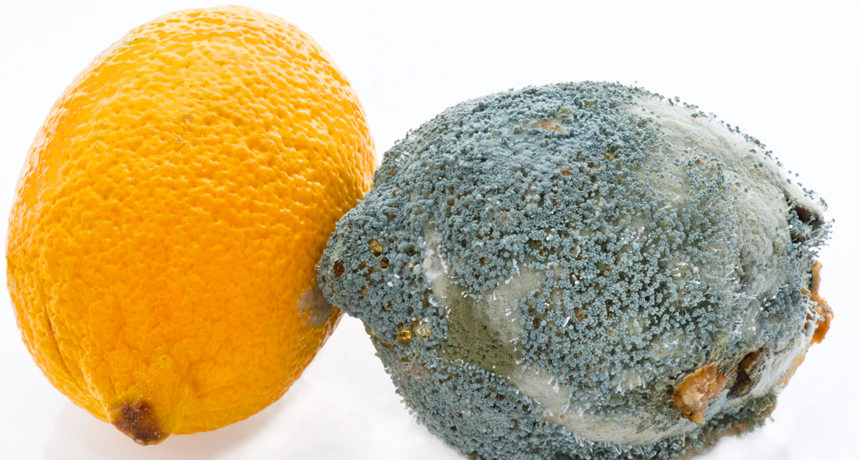Explainer: Where antibiotics came from
The medical community took a lesson from nature

The first antibiotic was created from a Penicillium mold, like the one shown here covering the rotting lemon (at right).
habari1/iStockphoto
Share this:
- Share via email (Opens in new window) Email
- Click to share on Facebook (Opens in new window) Facebook
- Click to share on X (Opens in new window) X
- Click to share on Pinterest (Opens in new window) Pinterest
- Click to share on Reddit (Opens in new window) Reddit
- Share to Google Classroom (Opens in new window) Google Classroom
- Click to print (Opens in new window) Print
By Esther Landhuis and Janet Raloff
Every now and then, scientists stumble by accident upon something groundbreaking. Penicillin is one example. It is the world’s first known antibiotic. Since its discovery, this germ killer and others have saved millions of lives.
In 1928, Alexander Fleming was a scientist at St. Mary’s Hospital in London, England. For one experiment, he spread a layer of “food” across covered glass plates, known as Petri dishes. Then he added a small number of bacteria and left them to grow. In the meantime, he took off for his summer vacation. When he got back, he found mold growing on some plates of the bacteria.
Usually mold is unwelcome — to people rooting around the kitchen fridge and scientists alike. But as Fleming probed the Petri dishes closely under a microscope, he witnessed something amazing. Wherever the mold was, the bacteria had disappeared! It had killed the germs. In 1930, Fleming published data showing that this mold was especially effective at killing several common bacteria that cause disease: streptococcus, staphylococcus and diphtheria.
Years later, other scientists conducted more tests. Among them were Howard Florey and Ernst Chain. The pathologist and chemist both worked at England’s Oxford University. Eventually, they helped figure out how to purify enough penicillin to treat bacterial infections in people. The Nobel Prize committee would cite these achievements when it gave its 1945 award for medicine to Fleming, Florey and Chain.
Penicillin proved invaluable in fighting infections during World War II. But the high rates of battlefield injuries during the early 1940s put a lot of pressure on U.S. drug makers to boost their supplies for the troops in Europe and Asia. That left too little for doctors to meet all of their needs back home.
Several ever-resourceful doctors in Pennsylvania got around the problem by making the antibiotic in their home kitchens (not a good idea, by the way). Julius Vogel of Aliquippa, Pa., reported spending no more than $5 on supplies for the batches he made at home. “The only apparatus I had used was the usual equipment found in the average family kitchen,” he told Science News in 1943. And within three weeks, he had already used the antibiotic to treat 29 of his patients.
In the years leading up to World War II, Germans began work on a separate class of antibiotics that would prove every bit as useful. They became known as sulfonamides, or sulfa drugs. The first of these was called Prontosil.
Gerhard Domagk, a German physician, was working with chemists at Bayer (the aspirin company) to see if chemical dyes could fight bacterial infections. That might sound a bit far-fetched, but here’s what they were thinking. When growing bacteria encounter a chemical dye, the dye sticks to the germs. Perhaps that dye also would stick to, and somehow kill, bacteria in people, they reasoned.
This hunch turned out to be correct, they showed in 1932. And sulfa drugs soon became the first antibiotics available for use in humans. Although initially used in Europe in early 1935, American doctors would begin prescribing them by late 1936.
These drugs and the antibiotics that followed them would prove a game changer. They transformed deadly infections into diseases that could be easily cured. Everyone recognized their value. That’s why Domagk won a Nobel Prize for Medicine in 1939. It was a mere seven years after his sulfa drugs were first tested. (Many Nobel winners do not take home their prize until 20 to 40 years after their initial achievements. Unlike with sulfa drugs, it might take that long for science to recognize how important their work was.)
Power Words
antibiotic A germ-killing substance prescribed as a medicine (or sometimes as a feed additive to promote the growth of livestock). It does not work against viruses.
bacteria Single-celled organisms forming one of the three primary domains of life. These dwell nearly everywhere on Earth, from the bottom of the sea to inside of animals.
germ Any one-celled microorganism, such as a bacterium, fungal species or virus particle. Some germs cause disease. Others can promote the health of higher-order organisms, including birds and mammals. The health effects of most germs, however, remain unknown.
pathology The study of diseases and/or conditions that lead to death. People who work in this field are called pathologists. They look at what causes a disease, how symptoms develop and may examine all stages of an illness.
penicillin The first antibiotic (although not the first one used on people), it’s a natural product that comes from a mold.
Petri dish A shallow, circular dish used to grow bacteria or other microorganisms.







